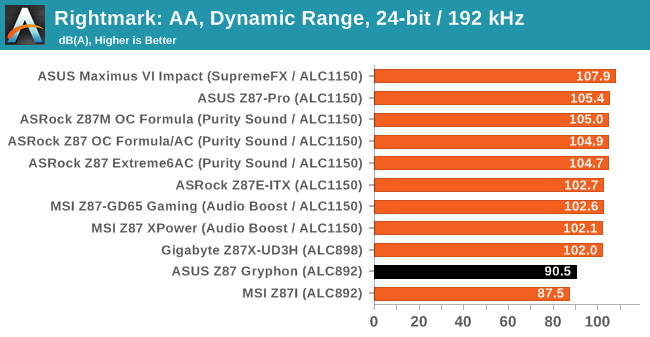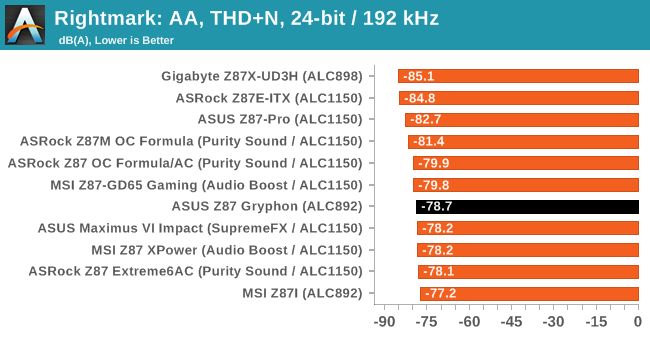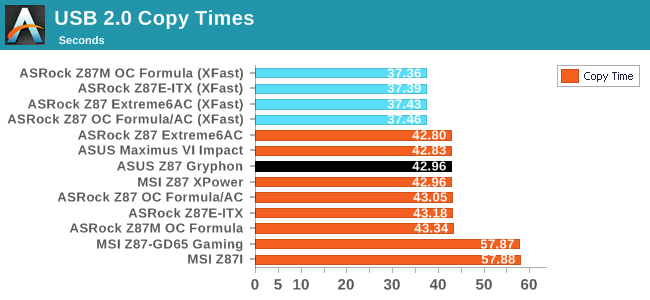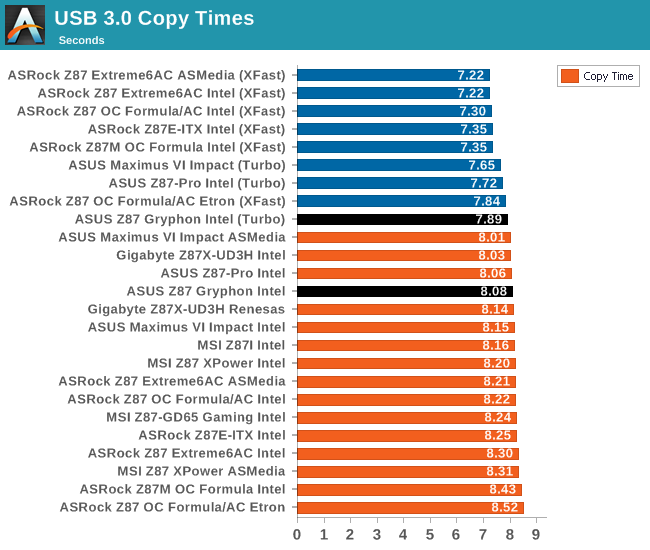ASUS TUF Z87 Gryphon Review
by Ian Cutress on February 3, 2014 10:00 AM EST- Posted in
- Motherboards
- Asus
- Z87
- TUF
System Benchmarks
Rightmark Audio Analyzer 6.2.5
In part due to reader requests, we are pleased to include Rightmark Audio Analyzer results in our benchmark suite. The premise behind Rightmark:AA is to test the input and output of the audio system to determine noise levels, range, harmonic distortion, stereo crosstalk and so forth. Rightmark:AA should indicate how well the sound system is built and isolated from electrical interference (either internally or externally). For this test we connect the Line Out to the Line In using a short six inch 3.5mm to 3.5mm high-quality jack, turn the OS speaker volume to 100%, and run the Rightmark default test suite at 192 kHz, 24-bit. The OS is tuned to 192 kHz/24-bit input and output, and the Line-In volume is adjusted until we have the best RMAA value in the mini-pretest. We look specifically at the Dynamic Range of the audio codec used on board, as well as the Total Harmonic Distortion + Noise.


Using the ALC892 for the Gryphon seems the right choice of codec, however it is limiting in terms of SNR compared to the ALC898 and above models.
USB Backup
For this benchmark, we run CrystalDiskMark to determine the ideal sequential read and write speeds for the USB port using our 240 GB OCZ Vertex3 SSD with a SATA 6 Gbps to USB 3.0 converter. Then we transfer a set size of files from the SSD to the USB drive using DiskBench, which monitors the time taken to transfer. The files transferred are a 1.52 GB set of 2867 files across 320 folders – 95% of these files are small typical website files, and the rest (90% of the size) are the videos used in the WinRAR test. In an update to pre-Z87 testing, we also run MaxCPU to load up one of the threads during the test which improves general performance up to 15% by causing all the internal pathways to run at full speed.


USB 3.0 Turbo boost provides an ample improvement in peak read speeds, although this does not translate in to much gain in the copy test.
DPC Latency
Deferred Procedure Call latency is a way in which Windows handles interrupt servicing. In order to wait for a processor to acknowledge the request, the system will queue all interrupt requests by priority. Critical interrupts will be handled as soon as possible, whereas lesser priority requests, such as audio, will be further down the line. So if the audio device requires data, it will have to wait until the request is processed before the buffer is filled. If the device drivers of higher priority components in a system are poorly implemented, this can cause delays in request scheduling and process time, resulting in an empty audio buffer – this leads to characteristic audible pauses, pops and clicks. Having a bigger buffer and correctly implemented system drivers obviously helps in this regard. The DPC latency checker measures how much time is processing DPCs from driver invocation – the lower the value will result in better audio transfer at smaller buffer sizes. Results are measured in microseconds and taken as the peak latency while cycling through a series of short HD videos - under 500 microseconds usually gets the green light, but the lower the better.

Once again the Z87 platform gives another 150+ result, showing that there is something fundamental with it causing a higher peak DPC than older Intel platforms.










62 Comments
View All Comments
HandsomeChow - Wednesday, February 12, 2014 - link
The TUF components used have still to be tested but considering they are willing to backup the board with a five year warranty shows that they won't actually be using average run of the mill mosfets, caps and inductors right? Since it would actually negatively effect them if they use crappy-average quality electronics since it will cost more for them to replace the entire board for defective mosfets or inductors.Plus, the TUF series has one thing no other motherboards have and that is the advance thermal management and monitoring software. Which in my opinion is what stands out the most on the TUF series.
BernardP - Monday, February 3, 2014 - link
It's disappointing they went with the run-of-the-mill Realtek ALC892 audio codec, instead of the better ALC1150.Sivar - Monday, February 3, 2014 - link
The ATX "Sabertooth" model uses an ALC1150.DanNeely - Monday, February 3, 2014 - link
This is a somewhat general question; but is there any easy way to determine if a mobo's large number of USB3 ports are due to additional controllers or just to the use of onboard USB3 hubs?TGressus - Tuesday, February 4, 2014 - link
Manufacturer's website specifications, or product manual.https://www.asus.com/Motherboards/GRYPHON_Z87/#spe...
Teardroop - Monday, February 3, 2014 - link
I get the retail Armor Kit and it already has protectors for all the connectors, ALL! Audio, Video, USB, Ethernet, Internal USB, not just PCI-E and memory... I like it..bigboxes - Tuesday, February 4, 2014 - link
Why do you like it (besides it looking cool and all)?Tjalve - Tuesday, February 4, 2014 - link
So.. No ECC support and no C-series chipset. This is just a regular Asus board with 5 year warrenty and an optional platic cover that do more harm then good. Or am I missing somthing?ShieTar - Tuesday, February 4, 2014 - link
Why would you expect Server-Features from a board labeled "The Ultimate Force"?ShieTar - Tuesday, February 4, 2014 - link
"The Gryphon also offers an additional ‘Fan Overtime’ feature which keeps the fans spinning after the system is shut down in order to allow the equilibration of air inside and outside the case. This can be seen as important in humid climates, where hot air inside the case can cause inside condensation as it cools down."Can somebody explain to me why this would happen? If the air inside the case is just heated up air from the outside, then it absolute water content cannot be over the dew point of the outside air. So when you cool it back down to its original temperature, why would there suddenly be condensation? It's not like there are water reservoirs inside the case to saturate the air.